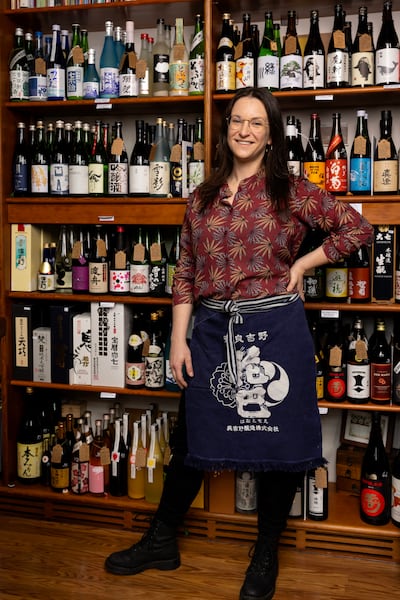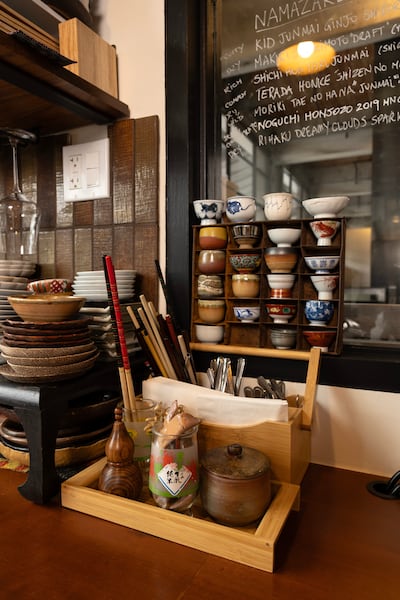Nina Murphy, who owns Portland’s Sunflower Sake, is a tireless missionary for its namesake drink. Her shop began in 2021 as a pop-up at Northeast Killingsworth’s Dame, and shortly afterward opened as a standalone in the Central Eastside’s Olympic Mills building. A big part of Murphy’s work is sake education and awareness, and though cultivating a proper palate is best served by actual tasting, a good first step is understanding what the tradition-steeped rice wine is all about. (It isn’t, for example, actually wine.) We asked Murphy to help us correct a few common misconceptions about the liquor and distill a few unlikely truths about Portland’s role in the stateside embrace of it. (It’s also not a liquor, nor is it distilled.)
OK, so sake’s not wine. It’s fermented—does that make it beer?
Sake is sake. “It’s a little contentious,” Murphy says. “It’s enjoyed like wine, the alcohol levels (around 15% by volume) are like wine, and [it’s called] rice wine for ease of description. From a technical perspective, the method of manufacture is closest to beer.”
According to strict national standards, Japanese sake must contain only water, rice, yeast, and the all-important koji mold specially cultivated to perform the same function as malting in beer—that is, to produce enzymes that create flavor profiles and convert starch to sugar.
When it comes to sake taxonomy, Murphy says, “the two big categories we use are fruity/floral versus savory flavor profiles.” Numbers printed on sake labels—say, 50%, or 70%— indicate what percentage of rice grain has been removed in the brewing process. “Since you find the highest concentration of starch within the center of a rice grain, new styles are unlocked as more and more of the grain is milled away,” she explains. “Take [away] 10% and you have a sake stout. Remove an additional 20%, and it’s more like red wine.”
That said, she adds, “You can’t go into a store and get a really good idea of what [a sake] will taste like based on the label—a huge range of sweet vs. malty vs. dry flavors [are] left open to the individual brewer and their house style.”
Sake is Japan’s national beverage, right?
It is, but generational shifts have impacted Japan’s homegrown industry in a big way. “Almost half of the breweries have closed their doors since the 1970s. Sake’s [seen as] sort of uncool— what grandpa drinks,” Murphy says. “Old-school brewers don’t have any idea how to rebrand for a younger audience or attack the global market.” But, she adds, Japan’s old guard has been “extremely happy to see other creatives reinvent their drinks and reinterpret sake’s space in the modern lexicon.”
For the sake-curious who tend not to sip alcohol on its own, Murphy recommends a liqueur called yuzu—a sake base that’s infused with fresh citrus and rock sugar. “It tastes like a wonderful sweet-and-sour adult lemonade with a gorgeous perfume.” For those ready to jump right in, she says, “there’s a style called junmai ginjo that’s light, smooth, elegant with a fruity, floral aroma and touch of natural sweetness—the white wine of the sake world.”
Is sake consumed hot? Cold? Both?
When sushi became a U.S. dining trend in the 1980s—and sake along with it—the only thing Reagan-era Americans seemed sure of was the importance of heating up each round. By the mid-2000s, the prevailing stateside belief was that chilled sake was better sake. The actual answer is more complex. In the past, Murphy explains, “the sake exported to the United States was low-quality table sake mostly enjoyed for the novelty of immersive experience at an izakaya or restaurant.” And while she agrees that chilled sake can be delicious, “I encourage a gen- tly warm ‘bathtub’ feel, around 120 degrees. It’s a temperature that’s typically very easy to achieve for a sake to taste that little bit fuller and sweeter and rounder as the flavors change.”

That said, she also highlights an unpasteurized sake style called namazake. “Better restaurants stick them in the fridge during spring and summer. They’re very bright and complex, full of flavor, with this exciting freshness. Namazake is particularly wonderful on toast with olive oil, or with cheese and fresh herbs for that bright zippy acidity and high intensity. There’s just life to it.”
Does sake still pair best with Japanese food, though?
“It’s a wonderful drink on its own merits,” Murphy says—and, indeed, the myth that sake equals Japanese food is one that has negatively impacted the sake industry, particularly during the pandemic. While alcohol sales overall soared thanks to a newly day-drinking populace, “sake was disproportionately affected because people weren’t sure how to enjoy it at home,” she says. “That’s why I opened my shop. So many people have really enjoyed sake at restaurants but had no idea how to find a bottle.”
Murphy is thrilled by a recent trend toward normalizing aged sake (koshu), a caramel-colored variant resembling whiskey. “Among sake fans, there’s still a misconception that aged sake is of low quality, but it can absolutely have the most beautiful flavors—sherry, caramel, dried fruits— and [it] tastes gorgeous with charcuterie or cheese.”
Portland: Saketown, USA?

We certainly have the demand, Murphy says, along with a wealth of Japanese restaurants and izakayas. “Portland’s a lit- tle sake nexus—we’re one of the highest per capita consumers in the United States.” Beer and wine get the local shine, but Murphy points out that Forest Grove’s SakeOne, which opened in 1992 as a retailer-importer, has been brewing craft sake for almost three decades. It was the oldest premium sake brewery owned by Americans, Murphy notes, until 2011, when the Tohoku earthquake and subsequent Fukushima nuclear disaster forced Fukushima’s Shirafuji brewery to transplant its more than 350-year-old business across the Pacific to Woodinville, Wash.
“They brought 24 generations of family [brewing] history to just north of Seattle,” she says. “It’s one of the most inter- esting places to taste sake and participate in that long his- tory, but small brewers up and down the West Coast [are] endeavoring to replicate traditional Japanese techniques and making exceptional sake,” she says, name-checking Oakland, Calif.’s James Beard Award–nominated Den Sake brewery. “We’re still very much in the early days, but the future of sake in Portland shows promise.”
This story is part of Taster Magazine, Willamette Week’s new guide to the best of beer, wine and spirits in Portland. It is free and can be found all over Portland beginning Wednesday, April 17, 2024. Find your free copy at one of the locations noted here, before they all get picked up! Read more from Taster magazine online here.
